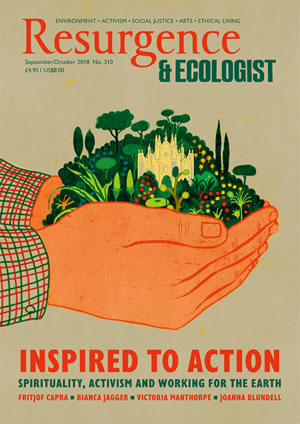Late afternoon toward the end of August. Sunlight, deepening to amber, pours into the orchard. It picks out the colours of the meadow flowers: the purple, thistle-like knapweed, now reaching almost waist height; a straggle of pinky-blue vetch; a clump of deep pink marjoram. Where the grass is shorter, golden spots of bird’s-foot trefoil gleam, commonly known as ‘butter and eggs’; hidden deeper in the undergrowth are the violet spikes of self-heal.
Altogether there are 27 species in the seed mix we scattered some seven years ago under the newly planted fruit trees. Every year I watch the progression of flowering, gradually learning to identify and name them. In March and April the cowslips and primroses push through the still-short grass, sprinkling the first bright spots of colour under the bare trees. In May, yellow rattle spreads in patches, weakening the grasses and so providing habitats for other low-lying plants. By early July the meadow is knee-high, dominated by ox-eye daisies. They raise bright faces to the sun, swaying in eddies of white and yellow as the wind catches them. Daisies are followed by creamy wild carrot – Queen Anne’s lace – and then by the deeper, autumnal colours I am seeing today.
By midsummer, the wildflower meadow is also a haven for insects. I recognise ladybirds, bumble- and honeybees, can identify many caterpillars; but I have not yet learnt to identify most of these fragile creatures. We often watch blue tits descending from the apple trees to pick caterpillars from the flowers. Then, as the pods ripen, a juvenile finch will perch precariously on a swaying stalk, delicately picking out the seeds.
As the year falls away from high summer, autumn fruitfulness arrives. By late August we have picked the plums, feasted on cherries, and eaten ripe greengages direct from the tree, experiencing what our grandchildren call a ‘taste explosion’ in our mouths.
The sun also lights up the ripening apples hanging above the meadow, each holding a pinky-red blush toward the sun as if striving to catch the fading warmth. Some – the early dessert apples growing in espaliers against the stone walls – are ready to pick. The older Bramley’s Seedlings are heavily laden, reminding me that John Keats observed a similar scene almost 200 years ago. He recorded in his famous poem ‘To Autumn’ how the sun-ripening apples bend down the trees; just as I have today.
Shadows lengthen as the sun drops toward the horizon just north of west. In midsummer it set much later and further north, bringing warmth well into the evening. Now it is noticeable how each day sunset shifts southerly, how the evenings draw in earlier and cooler. Can I experience directly in my body how the Earth’s trajectory begins to tilt our northern hemisphere away from the sun? Or is this just something I ‘know’ from science lessons?
On this late-summer evening, well past the longest day, I reflect back to spring and look forward to autumn. As I gaze across the meadow I realise that in not many weeks the grass will be dry and yellow. Before the equinoctial rains beat it down, it will be time to sharpen my scythe, cut the long grass, and cart it load by load down to the nearby horse stables. I look up at the hanging apples, imagine how I will harvest and store them. And how later, after the frosts have come, I will prune the trees to keep them in shape.
Am I sad to see summer fade? Not really, because my relationship with the orchard roots me in the passing seasons, helps me respond to the world with gladness as it changes around me. As the ancient Taoist sages taught, the ‘ten thousand things’ of our world continually emerge into presence, stay for a while, and then fall back into primordial absence. We notice this especially, maybe, with the beautiful things; the things that matter: the living Earth and her community of beings.







